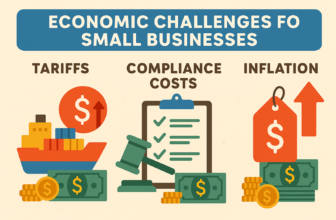Key Takeaways:
- Accounting automation software streamlines financial processes and reduces manual errors
- Saving time, working faster and better data accuracy are some of the benefits.
- These duties should be automated: entering data, creating invoices, reconciling, producing reports, managing expenses, processing payroll and filing taxes.
- Consider what your business requires which features are needed, how easy it is to use, how well it will expand and what support is offered
- Automating involves looking at the processes, picking the right software and training the users.
- Popular choices are QuickBooks, Xero, NetSuite, Sage Intacct and FreshBooks.
- With automation, accountants will need to do more strategic tasks.
What is Accounting Automation?
Accounting automation software is transforming the way businesses handle their financial processes. Accounting automation with technology makes it possible to skip manual data input, spreadsheets and lengthy reconciliations. They automatically record data, create ledger entries, make reports and update the records. Therefore, they help save a lot of time and money.
Automating accounting processes is all about working smarter, not harder. Instead of spending time on routine work, accounting professionals have more energy to focus on higher-value activities that really impact their organizations. With the right accounting software automation in place, finance teams become more strategic partners to the business.
Benefits of Accounting Automation
The advantages of using automated accounting systems are numerous:
- Time is saved – Automation gets rid of the need for many manual tasks, especially during stressful periods like financial closing. Jobs that took a lot of time before are now done much more quickly.
- Increased productivity – Since routine jobs are done automatically, accountants have extra time for important activities. They are able to process data, create insights and help with important business decisions.
- Enhanced accuracy – By reducing human touchpoints, accounting automation software minimizes errors in data entry and calculations. This results in financial data that stakeholders can depend on.
- Constant access to data – Management gets automatic access to financial updates, enabling them to quickly spot any issues and take the right actions. Finance teams can see results as soon as a transaction is settled.
- Cost efficiency – While there may be an initial investment in accounting software automation, the long-term cost savings are significant. Less manual work is needed, so organizations often reduce the number of people in their accounting teams.
- Improved compliance – Automation allows companies to remain up-to-date with all the new accounting rules and standards. Systems are able to be set up to obey rules and alert users if something goes wrong.
Challenges of Manual Accounting
Instead, dealing with accounting tasks manually is often difficult:
- Human errors are common in such systems and these can quickly escalate into major concerns.
- It takes a lot of time for manual procedures such as data entry and reconciliations, sometimes even days.
- Because manual methods are slower, it is usually difficult to get a current view of how the business is doing.
- It is hard to follow changes and keep a clear record when using paper and spreadsheets.
- Documents stored on paper can be lost, damaged or someone might access them without permission which creates risks for data security.
Key Tasks to Automate
In which accounting areas should you first consider using automation? These are some of the fields that have made the biggest impact:
Entering data and sorting transactions
- Invoice management and paying vendors and customers
- Matching bank and credit card records
- Preparing statements and financial reports
- Managing and reimbursement of employee expenses
- Handling payroll and taking taxes from employees
- Tax reporting and following regulations
Automation of these key accounting tasks with software allows businesses to become more efficient and focus extra resources on more important tasks.
Choosing the Right Accounting Software
Since there are many accounting automation tools available, how should you select the one that fits your needs? Here’s what to look at:
- Business requirements – Think about how many transactions you will need to manage, what your industry needs and where you are heading. Go for a solution that will be able to support your growth over time.
- Automation – Assess how the systems can be automated, how they integrate with existing systems, what reports are available and how data is kept secure. A good tool should help your team work better together.
- Intuitive interface – Look for a system that is simple to use so your team can pick it up quickly. Using complex systems means that fewer resources are put to good use.
- Adaptability – Your accountancy software should be able to change with your company as it grows. Select solutions that are adjustable and able to connect with main business systems.
- Support from vendors – Remember to look for help and information available from the company. Focus on picking a company that will actively help you achieve your goals.
Steps to Get Started
Once you’ve chosen your accounting automation software, how do you ensure a smooth implementation? Do the following important steps:
- Analyze your existing processes and see where automation could be used to simplify things. Find out from your team members what their biggest issues are.
- Assemble a special team to manage the rollout of the plan. Have members from accounting, IT and any other affected areas join the meeting.
- Set up the software according to your needs such as the chart of accounts, how approvals are handled and the formats of reports. Test the site repeatedly before opening it to the public.
- Guide everyone in using the new system and underline how it can save them time and effort each day. Continue to help as they start using the new system.
- Set up a process to measure the system’s performance once it is live and ask the team for their thoughts. Work on improving how things are done and make more use of automation tools.
Top Automation Tools for Accounting
Accounting software provides many ways to make working with finances simpler and faster. Below are some of the most often picked films:
QuickBooks – Because of its intuitive design and wide range of features, QuickBooks is popular among small to mid-sized businesses. It makes it simple to automate accounting tasks.
Quickbooks
Best suited for small businesses, freelancers, startups, and mid-sized companies across various industries like retail, construction, and professional services
Rasons to buy
- + User-friendly interface with real-time financial tracking and reporting
- + Automates tasks like invoicing and reporting
- + Provides robust inventory tracking and customizable reports
- + Integrates seamlessly with third-party apps
Possible Drawbacks
- –File size and user limitations may hinder scalability for larger operations
- –Limited customization options and industry-specific functionalities
- ● Plans range from $20/month
- ● Payroll add-ons start at $50/month
Xero – It is popular because of its wide range of third-party apps that integrate with the platform. Xero makes it easy to connect all parts of your business for better accounting.
Xero
u003cp style=u0022text-align: left;u0022u003eIdeal for small businesses, startups, freelancers, accountants, and bookkeepers seeking efficient, user-friendly cloud-based accounting solutionsu003c/pu003ernu0026nbsp;
Rasons to buy
- + Unlimited users across all plans
- + Simple setup and intuitive design with minimal learning curve
- + Strong invoicing, expense tracking, and bank reconciliation features
- + Multi-currency support in premium plans
Possible Drawbacks
- –No direct customer support calls
- –Entry-level plan restricts invoices and bills
- –Unsuitable for large businesses with high transaction volumes
- ● Early Plan: $15/month
- ● Growing Plan: $47/month
NetSuite – Being an enterprise-class solution, NetSuite gives users a flexible platform that covers financial, inventory, CRM and ecommerce needs. Automation is best suited to bigger and more complicated organizations.
Netsuite
Best suited for mid-sized and enterprise businesses, startups, and high-growth companies requiring scalable, modular ERP solutions. It supports industries like manufacturing, retail, professional services, and wholesale distribution
Rasons to buy
- + Unified platform integrates financials, CRM, inventory management, and more
- + Built-in multi-currency, multi-language, and multi-subsidiary support
- + Pre-configured best practices for faster implementation
Possible Drawbacks
- –Complex setup and configuration processes can be time-intensive
- –User interface may feel overwhelming for new user
- ● User licenses cost $100–$200 per user/month
Sage Intacct -is designed for growing companies and helps with automated accounting that can be adjusted to fit your requirements. It is recognized for having good financial reporting.
Sage Intacct
Ideal for small and medium-sized businesses, startups, solopreneurs, and freelancers. It supports service-based operations, product sales, and international transactions with multi-currency features
Rasons to buy
- + Automated invoicing, payments, and bank reconciliation save time
- + Scalable plans for growing businesses
- + Integration with apps like Stripe and Lightspeed
- + Strong security measures and automatic data backup
Possible Drawbacks
- –Setup complexity may require expert assistance
- –No time or mileage tracking features in basic plans
- ● Basic plans start at $10-$25/month for small businesses
- ● Sage 50 Pro: $59.50-$64.92/month
FreshBooks – Small business owners and freelancers find it useful for creating invoices, monitoring expenses and managing time. The mobile app helps you get things done anywhere.
FreshBooks
Best suited for small business owners, freelancers, and service-based businesses with limited inventory needs. It caters to industries like consulting, creative services, and IT, focusing on businesses with up to 25 employees
Rasons to buy
- + User-friendly interface, ideal for non-accountants
- + Customizable invoicing with time tracking
- + Mobile app for managing finances on the go
- + Automated expense tracking and payment reminders
- + Integration with third-party apps (e.g., Stripe, PayPal)
Possible Drawbacks
- –Limited inventory management capabilities
- –Steep learning curve for some users
- –May be slow performance with large data volumes
- ● Lite Plan: $21/month (5 clients)
- ● Plus Plan: $38/month (50 clients)
Will Automation Replace Accountants?
With all this talk of accounting automation software, you might wonder—will accountants become obsolete? The short answer is no. While automation is undoubtedly transforming the pWith all this talk of best accounting automation software, you might wonder—will accountants become obsolete? The brief response is that it does not. Although automation is changing accounting, human knowledge and skills are still needed.
This is how accounting roles could change in the future:
- Transactional roles will be taken over by machines, but people will still be needed for difficult or unusual cases.
- Accountants will spend more time looking at data, supplying financial knowledge and supporting strategy making.
- Overseeing and optimizing automated accounting systems will be a key aspect of the job.
- Communication, forming relationships and creativity will be in greater demand as time goes on.
Being in the accounting field, we need to accept that technology handles repetitive duties. Because of this, we will be able to play a more strategic, future-minded role in our organization. We’re in a very exciting period!
Conclusion: The Future of Accounting Automation
The rise of automated accounting systems is a transformative force for our industry. By equipping finance teams with time-saving tools and real-time data, accounting software automation empowers us to drive the business forward.
Even though change may be unsettling, I am sure accounting professionals must learn to use automation to be up-to-date. We should try to improve our skills in analyzing information, using technology and understanding business. Human and machine will coexist and complement each other in our future, not compete.
If you haven’t yet explored how accounting automation software can benefit your organization, there’s no better time than now. Select a few main tasks to begin with such as invoicing or handling expenses. Once you notice efficiency improvements, continue to make use of these tools. Not long after using them, you’ll be surprised at how you got along without them.
Robots are being introduced to help us do more meaningful and fulfilling work. Welcome them warmly and happily. Accounting is becoming automated and this is a positive change.



